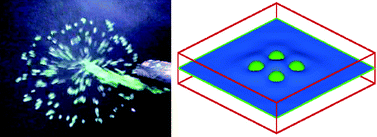In this review, we summarize the current state of understanding of the mechanisms that are important in determining the distribution of particles on fluid–liquid interfaces and of a technique that uses an externally applied electric field to control the microstructure of monolayers on interfaces. When particles come in contact with an interface they first disperse and cause particles already trapped on the interface to move away. The initial dispersion, which can be explosive for small particles on the surface of mobile liquids like water, is due to the fact that the capillary force pulls particles into the interface causing them to accelerate to a relatively large velocity. Since the motion of the particles is inertia dominated, they oscillate about the equilibrium position before coming to a stop under viscous drag. The observed spontaneous dispersion is a result of repulsive hydrodynamic forces that arise because of these oscillations. Then, after the forces causing dispersion subside, particles either cluster into monolayers under the action of attractive lateral forces or remain dispersed. The former scenario takes place for particles larger than about 10 µm for which attractive capillary forces can be significant and therefore such particles usually form tightly packed monolayers that normally contain defects and lack long-range order. The spacing between the particles of a monolayer can be controlled and defects eliminated by applying an electric field normal to the interface. This technique, in fact, also allows for the formation of monolayers of particles smaller than about 10 µm, as in the presence of the electric field the particles experience a force normal to the surface which gives rise to attractive lateral capillary forces. We also discuss the direct numerical simulation (DNS) and analytical approaches which have been used to understand and model these physical phenomena.

You have access to this article
 Please wait while we load your content...
Something went wrong. Try again?
Please wait while we load your content...
Something went wrong. Try again?


 Please wait while we load your content...
Please wait while we load your content...